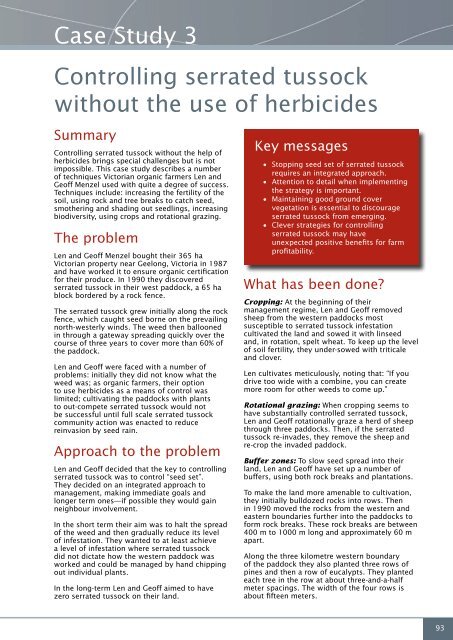Section 5 Case studies - Weeds Australia
Section 5 Case studies - Weeds Australia
Section 5 Case studies - Weeds Australia
Create successful ePaper yourself
Turn your PDF publications into a flip-book with our unique Google optimized e-Paper software.
<strong>Case</strong> Study 3<br />
Controlling serrated tussock<br />
without the use of herbicides<br />
Summary<br />
Controlling serrated tussock without the help of<br />
herbicides brings special challenges but is not<br />
impossible. This case study describes a number<br />
of techniques Victorian organic farmers Len and<br />
Geoff Menzel used with quite a degree of success.<br />
Techniques include: increasing the fertility of the<br />
soil, using rock and tree breaks to catch seed,<br />
smothering and shading out seedlings, increasing<br />
biodiversity, using crops and rotational grazing.<br />
The problem<br />
Len and Geoff Menzel bought their 365 ha<br />
Victorian property near Geelong, Victoria in 1987<br />
and have worked it to ensure organic certification<br />
for their produce. In 1990 they discovered<br />
serrated tussock in their west paddock, a 65 ha<br />
block bordered by a rock fence.<br />
The serrated tussock grew initially along the rock<br />
fence, which caught seed borne on the prevailing<br />
north-westerly winds. The weed then ballooned<br />
in through a gateway spreading quickly over the<br />
course of three years to cover more than 60% of<br />
the paddock.<br />
Len and Geoff were faced with a number of<br />
problems: initially they did not know what the<br />
weed was; as organic farmers, their option<br />
to use herbicides as a means of control was<br />
limited; cultivating the paddocks with plants<br />
to out-compete serrated tussock would not<br />
be successful until full scale serrated tussock<br />
community action was enacted to reduce<br />
reinvasion by seed rain.<br />
Approach to the problem<br />
Len and Geoff decided that the key to controlling<br />
serrated tussock was to control “seed set”.<br />
They decided on an integrated approach to<br />
management, making immediate goals and<br />
longer term ones—if possible they would gain<br />
neighbour involvement.<br />
In the short term their aim was to halt the spread<br />
of the weed and then gradually reduce its level<br />
of infestation. They wanted to at least achieve<br />
a level of infestation where serrated tussock<br />
did not dictate how the western paddock was<br />
worked and could be managed by hand chipping<br />
out individual plants.<br />
In the long-term Len and Geoff aimed to have<br />
zero serrated tussock on their land.<br />
Key messages<br />
• Stopping seed set of serrated tussock<br />
requires an integrated approach.<br />
• Attention to detail when implementing<br />
the strategy is important.<br />
• Maintaining good ground cover<br />
vegetation is essential to discourage<br />
serrated tussock from emerging.<br />
• Clever strategies for controlling<br />
serrated tussock may have<br />
unexpected positive benefits for farm<br />
profitability.<br />
What has been done?<br />
Cropping: At the beginning of their<br />
management regime, Len and Geoff removed<br />
sheep from the western paddocks most<br />
susceptible to serrated tussock infestation<br />
cultivated the land and sowed it with linseed<br />
and, in rotation, spelt wheat. To keep up the level<br />
of soil fertility, they under-sowed with triticale<br />
and clover.<br />
Len cultivates meticulously, noting that: “If you<br />
drive too wide with a combine, you can create<br />
more room for other weeds to come up.”<br />
Rotational grazing: When cropping seems to<br />
have substantially controlled serrated tussock,<br />
Len and Geoff rotationally graze a herd of sheep<br />
through three paddocks. Then, if the serrated<br />
tussock re-invades, they remove the sheep and<br />
re-crop the invaded paddock.<br />
Buffer zones: To slow seed spread into their<br />
land, Len and Geoff have set up a number of<br />
buffers, using both rock breaks and plantations.<br />
To make the land more amenable to cultivation,<br />
they initially bulldozed rocks into rows. Then<br />
in 1990 moved the rocks from the western and<br />
eastern boundaries further into the paddocks to<br />
form rock breaks. These rock breaks are between<br />
400 m to 1000 m long and approximately 60 m<br />
apart.<br />
Along the three kilometre western boundary<br />
of the paddock they also planted three rows of<br />
pines and then a row of eucalypts. They planted<br />
each tree in the row at about three-and-a-half<br />
meter spacings. The width of the four rows is<br />
about fifteen meters.<br />
93

















